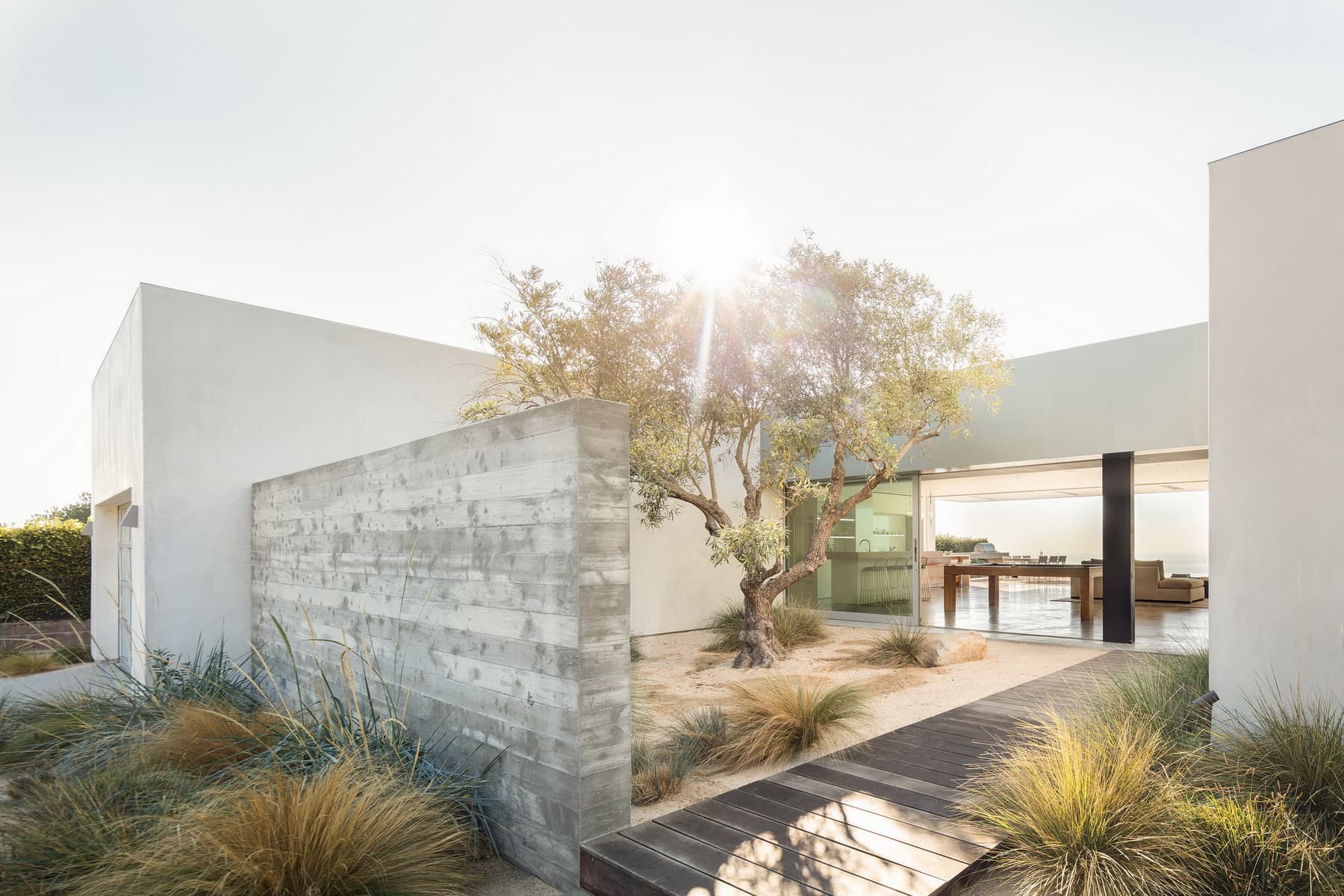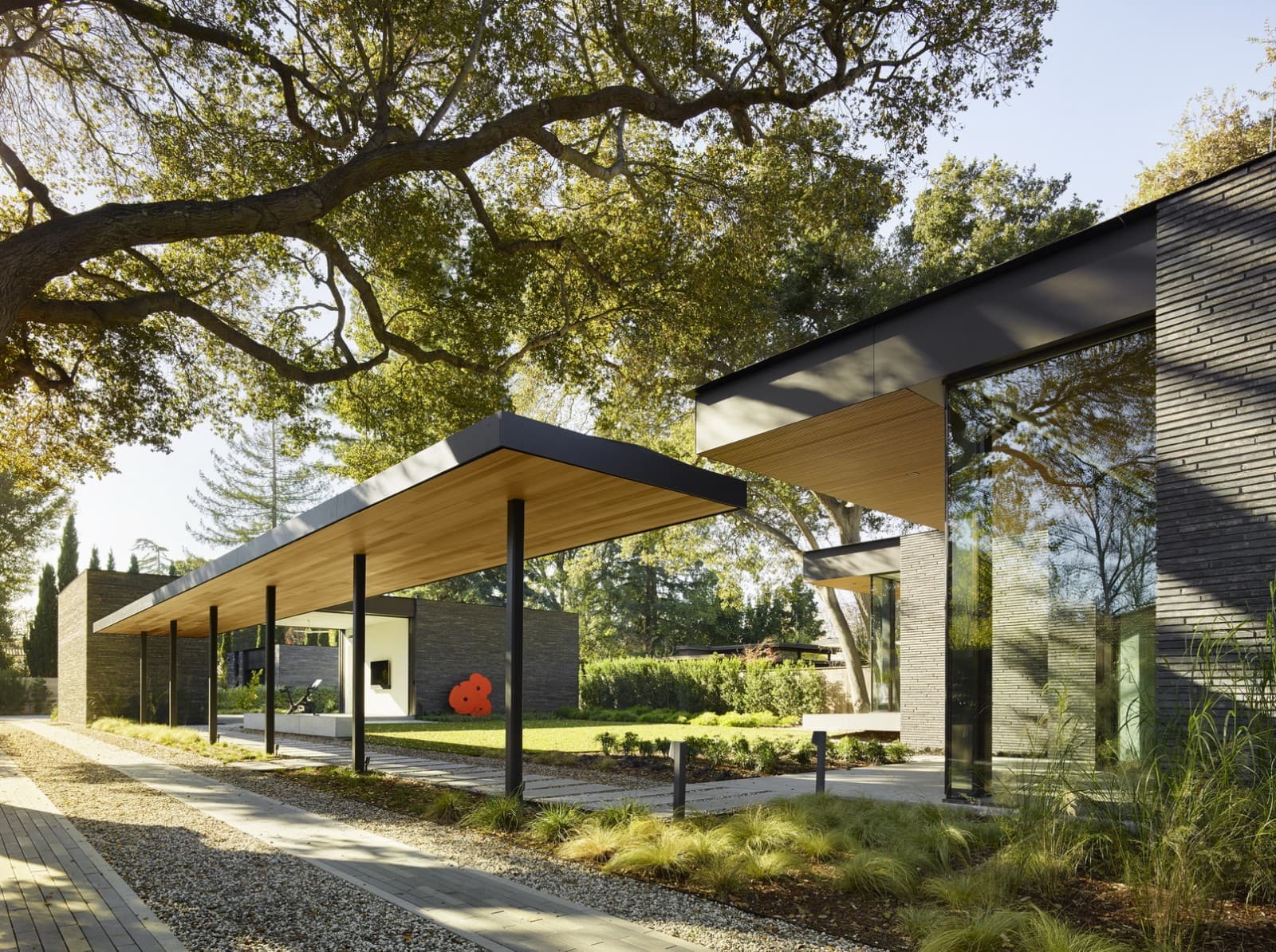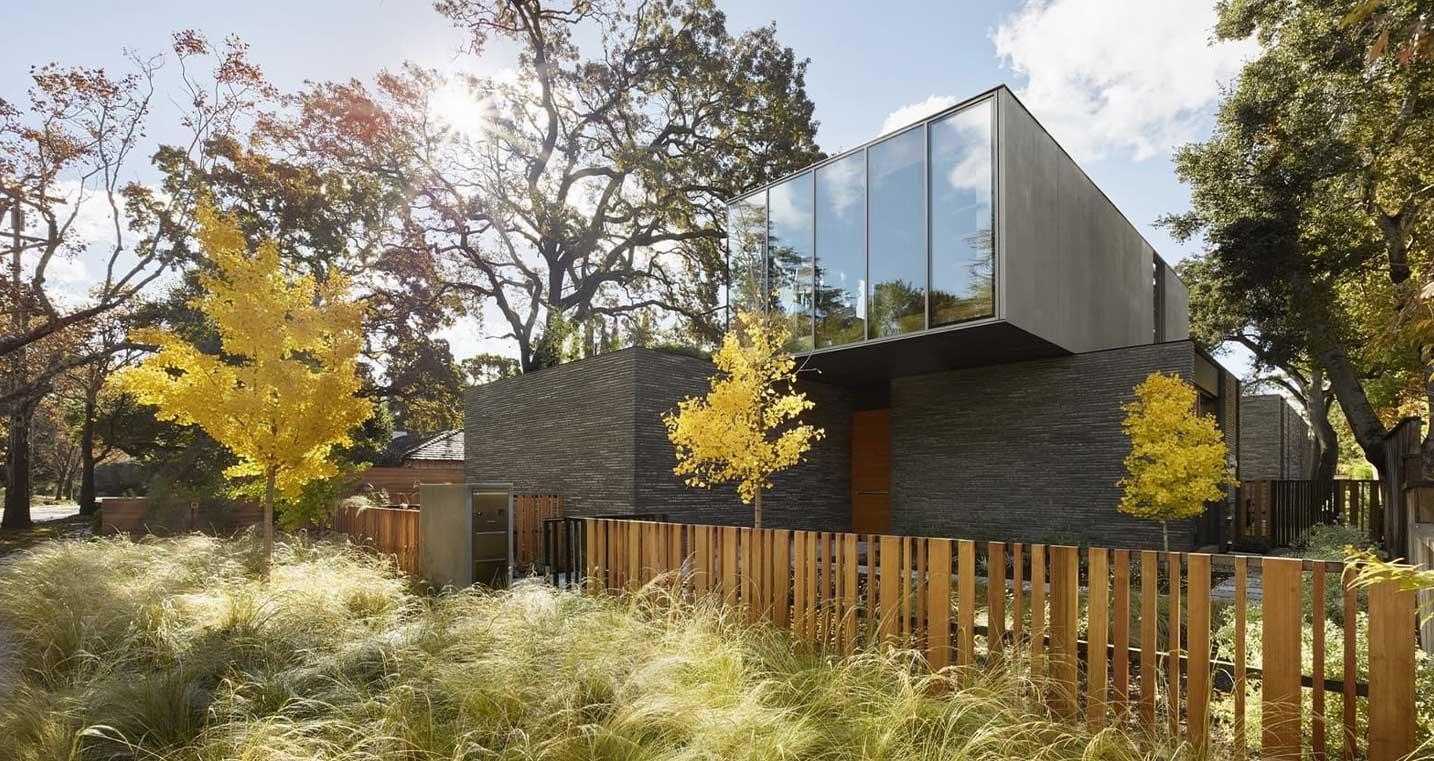/eyrc-ridge-mountain-home-with-dramatic-landscape-(feature).jpg?width=1200&name=eyrc-ridge-mountain-home-with-dramatic-landscape-(feature).jpg)
Written by Jessica Chang and Bryan Kim
While we are very proud of the architecture of our built homes, they would be nothing without the landscape design. The careful art that is taken by our collaborators always helps communicate and reinforce the underlying concept of each house.
The relationship between our houses and their landscapes is very symbiotic. We believe landscape design should begin alongside the design of the house. Properly siting the house within its site is the first step of determining how each project will be interacting with the land. With our ethos of bringing the outside in, our projects, and especially our residential projects, often focus around elements of nature.

WHAT CREATES GOOD LANDSCAPE DESIGN?
The key to excellent landscape designs is to use outdoor living spaces around a residence as a canvas to cater to the homeowner’s specific needs. Professional designers and architects will use their design experience to create beautiful exterior spaces that provide residents privacy and visual intrigue. This goal can be achieved through several techniques from including vertical planes to adding larger plants around the residence.

Below, we highlight four residential projects, each designed with a different landscape architect, to illustrate just how important this piece of the process is.
1. Using Landscape to Create Privacy
Above all else, homes should be considered safe havens for their residents. Whether they’re trying to get away from the noisy and fast-paced lifestyle of the city, or just value solitude greatly, people should be able to come home to relax and unwind from the outside world. Backyard landscape designs can play a major role in achieving this privacy as they can create the perfect barrier to enclose residents in their own personal paradise.
A perfect example of the amount of privacy landscaping can provide is clearly illustrated through the 19th Street residence.
Where: Santa Monica, CA
When: 2018
Landscape By: Lizz Speed Landscapes
Photos By: Matthew Millman
The focus of this project was to create privacy in an otherwise dense neighborhood, while also offering constant views to landscape throughout the house.
/eyrc-19th-street-residence-entrance.jpg?width=1000&name=eyrc-19th-street-residence-entrance.jpg)
In a dense Santa Monica neighborhood, landscape was used to create a private refuge at the 19th Street residence.
/eyrc-19th-street-residence-backyard.jpg?width=1000&name=eyrc-19th-street-residence-backyard.jpg)
/eyrc-19th-street-residence-landscape-design.jpg?width=1000&name=eyrc-19th-street-residence-landscape-design.jpg)
/eyrc-19th-street-residence-landscape-for-privacy.jpg?width=1000&name=eyrc-19th-street-residence-landscape-for-privacy.jpg)
The house and the rear yard are designed as interlocking L-shapes to create a landscape that envelops the house. Specific siting such as this allows landscape to be visible throughout the house. Pocketing doors and minimal thresholds in the living space integrate the outside seamlessly into the heart of the project.
/eyrc-19th-street-residence-enjoying-landscape-2.jpg?width=1000&name=eyrc-19th-street-residence-enjoying-landscape-2.jpg)
/eyrc-19th-street-residence-landscape-used-for-seclusion.jpg?width=1000&name=eyrc-19th-street-residence-landscape-used-for-seclusion.jpg)

The densely planted Ficus along the property line creates a green backdrop for the house and a tranquil space to relax in.
Hints of landscape appear, even in the more private areas of the home. Whether in the main space or the bedrooms, the connection of the outdoors is deliberately maintained.
2. Preserving the Existing Site
There are some unforeseen challenges designers might run into when a residence is surrounded by unique outdoor spaces. In fact, the focus of the Ridge Mountain project was landscape in an atypical setting. There was a desire to blend the home and landscape into the surroundings of a very natural site.
Where: Palm Springs, CA
When: 2019
Landscape By: InsideOutside, Inc.
Photos By: Joe Fletcher and Lance Gerber
/eyrc-ridge-mountain-home-with-dramatic-landscape.jpg?width=1000&name=eyrc-ridge-mountain-home-with-dramatic-landscape.jpg)
The landscape design for Ridge Mountain was a unique challenge. Located in the hilly desert near Palm Springs, we wanted to create a statement without being too jarring against the existing landscape.
Though the house sits on 2.72 acres of land, the home is held back in a modest footprint. The minimal footprint allows the natural landscape to sprawl and be appreciated from the house. The house’s unique materials take on earthen tones and the planting strategy aims to feel wild and natural to its surroundings.
/eyrc-ridge-mountain-simple-materials-echo-landscape.jpg?width=1000&name=eyrc-ridge-mountain-simple-materials-echo-landscape.jpg)
/eyrc-ridge-mountain-framing-desert-views.jpg?width=1000&name=eyrc-ridge-mountain-framing-desert-views.jpg)
All design decisions were made to frame and highlight the unique desert views. Simple geometry and subtle material tones allow nature to be the focal point. A wide expanse of sliding glass doors opens to the elements, with thick walls, and deep overhangs frame natural views while aiding in natural ventilation of the home.
/eyrc%20ridge%20mountain%20materials%20echo%20landscape.jpg?width=1000&name=eyrc%20ridge%20mountain%20materials%20echo%20landscape.jpg)
This idea of blending in with the surroundings is carried through to the interior material choices. The large organic stone floor tiles match the rocks existing on site. And as the material continues from the outdoor deck space, to the entrance, to the pool house, the distinction between the natural and built environment becomes quite blurred.
/eyrc-ridge-mountain-backyard-swimming-pool.jpg?width=1000&name=eyrc-ridge-mountain-backyard-swimming-pool.jpg)
The minimal pool edge creates a seamless plane from deck to water, deferring the view to the dramatic landscape beyond.
/eyrc-ridge-mountain-backyard-living-space.jpg?width=1000&name=eyrc-ridge-mountain-backyard-living-space.jpg)
The play between the manmade and the natural defines the project, adding an amount of timelessness to a sympathetic addition within the mountainside.
3. Establishing Tranquility & Privacy with Landscape
Similar to the first project in this list, the focus of the Crescent Drive project was to soften the relationship of the home to its surroundings while creating privacy in an otherwise dense neighborhood.
Where: Beverly Hills, CA
When: 2017
Landscape By: GSLA Studio
Photos By: Matthew Millman and Stephen Schauer
Like the first project in this list, the focus of this project was to soften the relationship of the home to its surroundings while creating privacy in an otherwise dense neighborhood.
In order to integrate the modern design of the Crescent Drive residence to the neighborhood, landscape was used to soften its relationship to the surrounding traditional homes.
In a choreographed procession, planting and a water feature slowly separates a visitor from the noise of the public realm into the private retreat within. This small piece of garden feels very special and is neither part of the front yard nor the rear yard—the lush density makes it feel like a little oasis. The feeling of compression in the meandering walkway creates a sense of release as the space opens up to the entry.
/eyrc%20crescent%20drive%20home%20landscape%20establishes%20tranquility.jpg?width=1000&name=eyrc%20crescent%20drive%20home%20landscape%20establishes%20tranquility.jpg)
/eyrc-crescent-drive-home-modern-interior.jpg?width=1000&name=eyrc-crescent-drive-home-modern-interior.jpg)
Opening up to the main interior area, views of landscape are continued across the room through a double height window facing the yard. Tree shadows cascade into the room, constantly changing as the day progresses.
/eyrc-crescent-drive-home-backyard-swimming-pool.jpg?width=1000&name=eyrc-crescent-drive-home-backyard-swimming-pool.jpg)
The use of water features continues in the rear yard. The sound of moving water can help block out road noise in more heavily trafficked neighborhoods. By using large pocketing doors, the peaceful sounds of falling water can be enjoyed from inside the house as well.
4. Incorporating Japanese Style into a Modern California Home
In the Kingsland project, the focus was to incorporate traditional Japanese elements into a home that embraces modern California design and flair.
Where: Los Angeles, CA
When: 2019
Landscape By: Terremoto Landscape
Photos By: Poketo Ye Rin Mok, Paul Vu, and Stephen Schauer
The landscape strategy for the Kingsland residence was to combine Japanese traditions with native California planting. At the entry, the house is enveloped by nature. The house recedes with its dark paint palette as the tall grasses grow freely. The way in which the house is set back in the landscape allows for a bit of drama as a visitor approaches the house.
Like in our other urban projects, the edges of the site are planted with taller species, in this case, feathery bamboo.
/eyrc-kingsland-interior-space.jpg?width=1000&name=eyrc-kingsland-interior-space.jpg)
The house opens up to frame the rear yard as the jewel of the house. Rather than a typical California lawn, the ground plane is defined by gravel and a rockscape. A single Palo Verde tree stands in the center of the yard as a solitary focal point. A round fire pit and wooden bench also act as additional features in the design.
/eyrc-kingsland-engawa.jpg?width=1000&name=eyrc-kingsland-engawa.jpg)
Recalling the engawa of traditional Japanese architecture, the extended porch adds an important layer between the outside and in. Habitable and functional, the backyard porch creates a place for contemplation and peace above the newly planted area. Both front and rear porches are lifted off the ground creating the illusion of floating. The light touch the architecture has on the landscape further prioritizes nature over the built environment.
Taking inspiration from traditional Japanese gardens, the Los Angeles home and landscape mix with modern Californian principles to create something new.
ELEMENTS OF PROFESSIONAL LANDSCAPING
Landscape design is truly dynamic, using elements of visual, audial, and olfactory to create an environment. Carefully curated, the landscape can turn a solitary home into a holistic study of space, movement and material. By collaborating closely with landscape designers, EYRC Architects strives to shape places that are inextricably woven into their surroundings while creating new moments of natural repose.



This article was written by Jessica Chang with Bryan Kim.

Written by Jessica Chang
Jessica Chang, AIA, is a graduate of the University of Southern California and an Associate at EYRC. She has led projects in both the commercial and residential studios since joining EYRC in 2018. With her passion for design, Jessica brings an energetic perspective and critical eye to the firm. Prior to her tenure at EYRC, Jessica worked at Morphosis Architects for four years on internationally recognized projects ranging from hotels and train stations, to embassies and city-scale masterplans. Her dedication to the field extends beyond design projects as she leads the Digital Practice Committee and co-leads the Design Justice Committee at EYRC. Her determination to innovate and promote equity makes her a valuable and empathetic architect.
